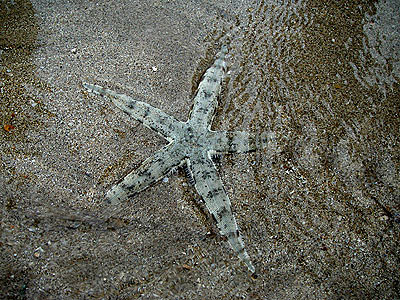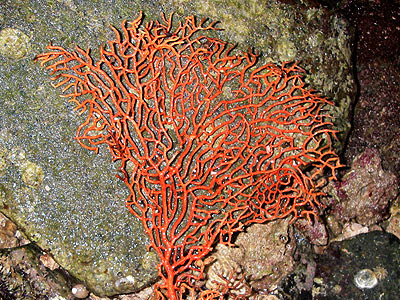The last time I went to Kusu Island was almost a year ago. We were with Dr Dan and his students then, and I saw quite a number of interesting things, including a nemo, i.e. a false clownfish (Amphiprion ocellaris) in a pool surrounded by lots of sponges and corals. Dr Dan wasn't with me then, and it was only later when I got to know they didn't managed to find any nemo that day :P
This time round, it's just the wildfilms crew and beachfleas. Zhiyuan and Weili decided to join me as well. We met up for a quick dinner before joining the others at Marina South Pier and took the boat to Kusu.
At Kusu, as we were heading towards the loo to do "you know what" before going into the lagoon, I heard someone yelling behind me.
"Don't go so fast! We want to follow you!"
Follow me to the loo???!!!????
She was one of the beachfleas who had also went with us to Sisters island the day before. But it's still quite bright now. And why did she want to follow a bunch of guys to go to the loo???!!!???
It then dawn on me that she thought that we were going into the lagoon, and she wanted to follow!!!
WAHAHAHAHahahaaaaa!!!!!
I yelled back at her that we were going to the loo, and everyone who heard us burst into laughter :D
Anyway, after the toilet break, we headed towards the lagoon. The first animal we saw at the sandy shore was this - a common seastar (Archaster typicus).
It was busy crawling over the sand, probably feeding on the organic particles (or detritus) on the surface.
I was really hoping to see nemos, but the water was a little murky and I had a bit of problem even to find the anemones. After searching high and low, and sinking to my knee at one point into the sand, I couldn't find any nemos despite finding quite a number of carpet anemones and magnificient anemones.
As the sky turned darker, we found a ghost crab (Ocypode sp.) on a patch of spoon seagrass (Halophila ovalis).
It was cream-coloured instead of the usual grey ones I've seen though, so not sure if this was a different species or just a colour variation. Ghost crabs are fast runners, and can move about 100 bodylengths per second, and they have excellent eyesight so as to see where they going. Otherwise, we will probably get a lot of dead ghost crabs on our shores, died from crashing into rocks or other hardy things :P
Most of the beachfleas were gathering around me then, some a little disappointed as we couldn't find the nemo. Hoping to show them more things, I decided to bring the gang to the reef near the jetty.
There were lots of zoanthids on the shore leading to the jetty, I really hoped we had not stepped on too many of them. On a rock near the jetty, we saw this beautiful Sally-light-foot crab (Grapsus albolineatus).
It is a scavenger, but also eats algae. And on another rock, we saw its close relative from the same family Grapsidae, a purple climber crab (Metopograpsus sp.)
Not to be confused with the tree-climbing or vinegar crabs (Episesarma spp. from the same family) found in mangroves and are primarily leaf-eaters (am clarifying this as I understand some beachfleas were confused), purple climber crabs mostly feed on algae, but they also scavenge and attack other small animals. I've seen them feeding on little fishes and sea slaters, though I'm not really sure if those were hunted or scavenged. They are quite common on our rocky shores, and can also be spotted in mangroves running over the roots and tree trunks.
As we walked along the rocky shore, I found a spiny oyster (Spondylus sp.) under a rock.
Unlike true oysters which cement to hard surfaces with their left valves, spiny oysters glued with their right valves.
As we walked towards the beacon, I spotted some reddish-orange thing smashing against the rocks with the waves. Picking it up, it was a loose sea fan (Order Gorgonacea)!!! Probably broken from its base by the dashing waves or something.
A sea fan is a colony of tiny animals (aka polyps) linked to each other, supported by a central rod made of a strong but flexible protein called gorgonin, which is similar to the material produced in the animal horns.
The water level was a little high when we reached the beacon and tide was rising. It was getting late and we decided to make our way back.
While this time round we couldn't find the nemo, it was nevertheless an interesting trip with a few good finds! :)
Thursday, February 22, 2007
Kusu Island on CNY Day 3
Subscribe to:
Post Comments (Atom)

6 comments:
Beautiful crabs! But how do u differentiate a "right" valve to a "left" valve? I mean for the spiny oyster u mentioned.
Thanks :) To differentiate the left and right valve, you will need to differentiate the anterior and posterior end first. Usually the longer end measured from the beak or the end with the growth rings further apart is the posterior side. And usually, if the ligament is on one side of the beak, it's on the posterior end. To distinguish the left and right valve, hold a clam in front of you with its opening side facing down, one hand on each valve, the anterior end pointing forward, and the posterior end facing you. The right valve will be the one in your right hand, and the left valve will be the one in your left hand.
Hi Ron, the pics you took are very nice.. do you post them in Flickr as well?
Thanks for the compliment, Helen :) I do post some of my photos on Flickr. Didn't quite have the time to update my ablum regularly though.
hor.. what is your flickr add?
Click here to get to my Flickr album. It also on the right panel of my blog's home page actually :)
Post a Comment